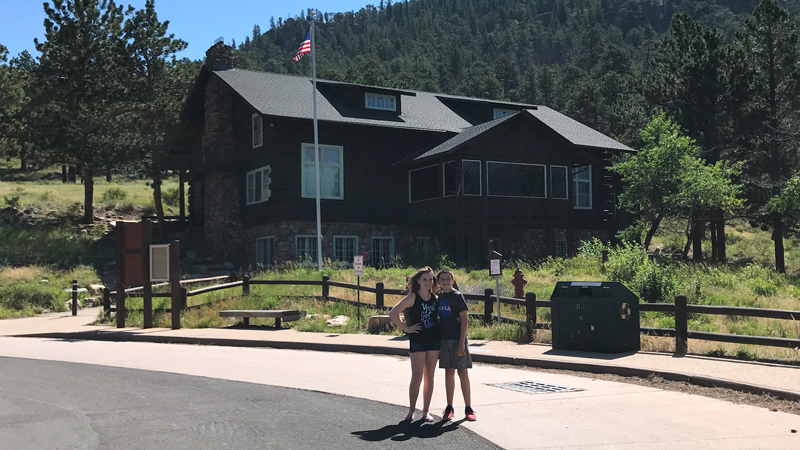
When planning our summer road trip and visit to Rocky Mountain National Park, I discovered that there are basically four major sections to the national park:
- Trail Ridge Road: The highest continuous road in the United States with several stunning scenic overlooks, including Many Parks Curve, Rainbow Curve, Forest Canyon Overlook, Rock Cut Overlook, Lava Cliffs Overlook, Gorge Range Overlook, Medicine Bow Curve, Milner Pass and the Continental Divide, and Farview Curve, as well as access to the Alpine Visitor Center, Kawuneeche Visitor Center, and Holzwarth Historic Site.
- Old Fall River Road: The first road to Rocky Mountain National Park’s high country, that is now an 11 mile, 15 mph, one-way nature drive with spectacular views and a 25 foot waterfall. The area also provides access to the Fall River Visitor Center, Sheep Lakes, Horseshoe Park, and the Alluvial Fan waterfall.
- Bear Lake Road: Begins near the Beaver Meadows Visitor Center and provides access to the Moraine Park Discovery Center, Sprauge Lake, Bear Lake, Alberta Falls, and several other popular trailheads.
- Wild Basin Entrance: The southeastern entrance station that provides access to more remote trails, picnic areas, Copeland Lake and Copeland Falls, several other lakes, and Ouzel Falls.
We spent the first day and a half in Rocky Mountain National Park exploring the areas along Trail Ridge Road and Old Fall River Road. We also explored the towns of Grand Lake and Estes Park. On our third day, we were excited to finally explore the lakes and waterfalls along Bear Lake Road and the Moraine Park Discovery Center was our first stop.
Moraine Park Museum And Amphitheater, also called the Moraine Park Discovery Center and the Moraine Park Lodge, are located off Bear Lake Road in Moraine Park, a glaciated meadow between two moraines in Rocky Mountain National Park.
Sitting just 1.5 miles from the Beaver Meadows Entrance Station, the Moraine Park Discovery Center opened in 1923 and features interactive natural history exhibits on the topics of geologic processes, glaciation, weather and climate, ecosystems, and human impact. There is also a small bookstore, a short nature trail, and beautiful views of Moraine Park.
From the visitor center, you can see the Big Thompson River and in the surrounding meadows, you’ll often see deer and elk.
Moraine Park Museum and Amphitheater
The Moraine Park Museum and Amphitheater sits at roughly 8,100 feet elevation, in the northeast corner of Moraine Park at the base of Eagle Cliff Mountain.
In the 1870s, many tourists fell in love with the beautiful Moraine Park meadows and ended up homesteading in the area. One of the homesteaders was Imogene Greene MacPherson, who between 1905 and 1923, built the Moraine Lodge. It was a collection of rustic buildings and tourist destination, but after her death in 1928 and the Great Depression of the 1930s, the lodge struggled to survive.
In 1931, the National Park Service bought the property and turned it into the Moraine Park Visitor Center. Their alterations to the property focused on preserving the wildness of the park —l a trend that was seen across all of the national parks.
During the early 1930s, the Civilian Conservation Corps (CCC) removed most of Moraine Lodge, restoring the land to its “natural” state.
By 1936, the CCC converted the Moraine Lodge Assembly Hall into a National Park Service museum and began construction on a new amphitheater nearby. The amphitheater design followed rustic, natural design principles, using native plants and materials, and building to the natural shape of the land. Today the amphitheater is used for K-12 education programs and as a wedding ceremony site.
Know Before You Go
- The Moraine Park Discovery Center, also known as the Moraine Park Museum And Amphitheater and the Moraine Park Lodge, is located on Bear Lake Road in Estes Park, Colorado 80517, in Larimer County in Rocky Mountain National Park, just 1.5 miles from the Beaver Meadows Entrance Station.
- It is one of five visitor centers spread throughout the park.
- It is open daily late Spring through mid-Fall from 9:00 am to 5:00 pm with reduced hours in late fall and spring. It is closed during the winter.
- The Moraine Park Museum features interactive natural history exhibits, with themes including geologic processes, glaciation, weather and climate, ecosystems, and human impact.
- The Moraine Park Lodge building was listed on the National Register of Historic Places in 1976 and expanded to include the amphitheater in 2005.
- Food, drinks, and pets are not allowed in any park visitor centers. The National Park Service welcomes service animals that have been individually trained to perform specific tasks for the benefit of persons with disabilities.
- There are flush restrooms available, as well as free public WiFi.





